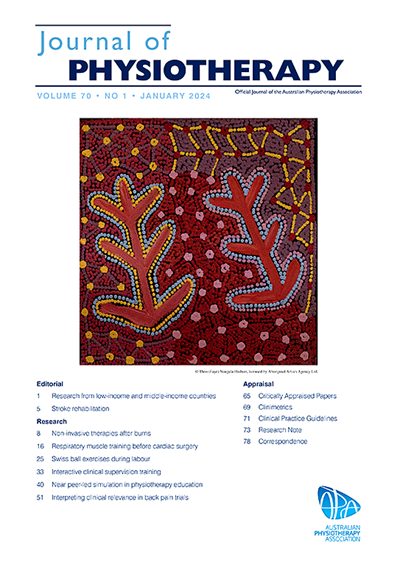膝关节骨关节炎运动管理的最新亮点和不确定性。
IF 9.4
1区 医学
Q1 ORTHOPEDICS
引用次数: 0
摘要
本文概述了2020年1月至2025年2月期间发表的膝关节骨关节炎(OA)运动管理的最新研究亮点和不确定性。方法:检索Medline、CINAHL Plus、Cochrane中央对照试验注册库和Cochrane系统评价数据库,以确定纳入的研究。对检索结果进行筛选,并在整个研究团队中讨论文章选择。被认为具有重要临床意义的研究,特别是高质量和/或有争议的研究被选择纳入。研究结果根据总体主题进行了总结,并为每个主题领域提出了未来的研究方向。研究发现:这篇综述强调了六个主题,并提出了以下问题:锻炼是否像之前认为的那样有效?运动是如何起作用的,谁可能受益最大?有没有最佳的运动剂量和运动类型?病人的依从性能得到改善吗?这重要吗?病人需要亲自去看医生进行锻炼吗?关于骨关节炎的交流如何影响患者对运动的看法?有几个与这些主题相关的关键发现。首先,运动对膝关节OA有效性的确定性降低。此外,运动改善临床结果的机制在很大程度上是未知的,也不清楚哪些人从运动中受益最多。研究未能证明运动与临床结果之间的剂量反应关系,提高患者对运动的坚持可能不会改善临床结果。尽管如此,运动疗法可以通过多种方法有效地远程提供。使用基于损伤的方法来沟通OA与对运动的负面看法有因果关系。本文章由计算机程序翻译,如有差异,请以英文原文为准。
Recent highlights and uncertainties in exercise management of knee osteoarthritis
Introduction
This narrative review outlines recent research highlights and uncertainties in the exercise management of knee osteoarthritis (OA) published between January 2020 and February 2025.
Methods
To identify studies for inclusion, these electronic databases were searched: Medline, CINAHL Plus, Cochrane Central Trial Register of Controlled Trials and Cochrane Database of Systematic Reviews. Search results were screened and article selection was discussed among the entire research team. Studies that were deemed to be of significant clinical importance, particularly high-quality and/or controversial were selected for inclusion. Study findings were summarised according to overarching themes and future research directions were suggested for each thematic area.
Findings
This review highlighted six themes formulated as questions: Is exercise as effective as previously thought? How does exercise work and who might benefit the most? Is there an optimal exercise dose and type? Can patient adherence be improved – and does it matter? Do patients need to be seen in person to deliver exercise? How does communication about osteoarthritis influence patient beliefs about exercise? There were several key findings related to these themes. First, there was reduced certainty in the effectiveness of exercise for knee OA. Additionally, the mechanisms by which exercise improves clinical outcomes are largely unknown and it is unclear which individuals benefit the most from exercise. Research has failed to demonstrate a dose-response relationship between exercise and clinical outcomes and improving patient adherence to exercise may not lead to improved clinical outcomes. Nonetheless, exercise therapy can be effectively delivered remotely via a variety of methods. Communicating about OA using an impairment-based approach has been causally linked to negative beliefs about exercise.
求助全文
通过发布文献求助,成功后即可免费获取论文全文。
去求助
来源期刊

Journal of Physiotherapy
ORTHOPEDICS-REHABILITATION
CiteScore
11.40
自引率
7.40%
发文量
69
审稿时长
72 days
期刊介绍:
The Journal of Physiotherapy is the official journal of the Australian Physiotherapy Association. It aims to publish high-quality research with a significant impact on global physiotherapy practice. The journal's vision is to lead the field in supporting clinicians to access, understand, and implement research evidence that will enhance person-centred care. In January 2008, the Journal of Physiotherapy became the first physiotherapy journal to adhere to the ICMJE requirement of registering randomized trials with a recognized Trial Registry. The journal prioritizes systematic reviews, clinical trials, economic analyses, experimental studies, qualitative studies, epidemiological studies, and observational studies. In January 2014, it also became the first core physiotherapy/physical therapy journal to provide free access to editorials and peer-reviewed original research. The Australian Physiotherapy Association extended their support for excellence in physiotherapy practice by sponsoring open access publication of all Journal of Physiotherapy content in 2016. As a result, all past, present, and future journal articles are freely accessible, and there are no author fees for publication.
 求助内容:
求助内容: 应助结果提醒方式:
应助结果提醒方式:


